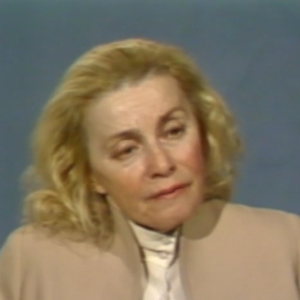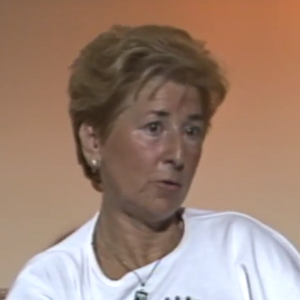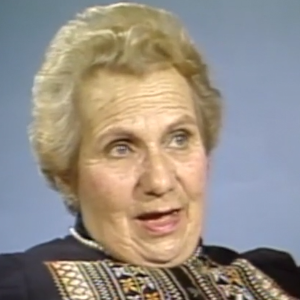Sara Ginaite-Rubinson
Sara Ginaite-Rubinson gives a detailed and deeply moving account of life in the ghetto as well as the massacre of Jews from the Kaunas ghetto in October 29, 1941.
Sara Ginaite-Rubinson was born in 1924 in Kaunas, Lithuania. Sara was the youngest of a well-educated family. Her mother, Rebecca, was a Polish school graduate. Her father, Yosif, studied Engineering in France, and her older sister, Alice Benn, had studied Commerce and French in Belgium. Anna’s father worked for different foreign companies with clients from Denmark, Belgium, and the US, importing raw material for textile manufacturers.
Sara remembers happy school years when she was around ten years old in 1934, living amongst many friends in Kaunas. The family had moved to live next to her mother’s family and Sara had just started a new school. Jewish parents took their children out of German private schools as Hitler gained power in 1933. Not knowing enough of the Lithuanian language for their children to be accepted to Lithuanian schools, parents in the area formed a new school for Jewish children, and Sara continued her education there. The area was mixed Lithuanian and Jewish; yet, the two groups lived separately: Sara remembers how they had everything “Jewish” from Jewish schools, sporting organizations to skating rinks.
Life changed in 1940 when the Soviet Union occupied Lithuania. Lithuanians, and many Jews including those active in the Zionist movement, politically affiliated, and business owners, were deported to Siberia. Jewish schools closed and students were sent to Lithuanian private schools; they now had to learn the Russian language, history, and geography. Apartment buildings were confiscated for Soviet military men and residents were evicted. Businesses were liquidated with their money devalued, including Anna’s father’s business. Anna’s father became very sick shortly afterwards and passed away.
In August, 1941, the Germans officially took control of Lithuania, and opened the ghetto in Kaunas where Sara and her family were moved. The ghettos closed on August 15th and the organized killings started. Sara’s family survived the selection and the ‘Big Aktzion’ of October 29th. Sara decided to resist as she witnessed the mass of 9200 people being marched up the hill to Ninth Fort. All 9200, including 4000 children, were shot by Lithuanians.
In the spring of 1942, Sara joined the Anti-Fascist Fighting Organization. In late 1943, Sara was part of the first group of inmates from Kaunas who made it to the Rudninkai Forest where they met with a detachment of partisan fighters known as “Death to the Fascist Occupiers”. Sara ran military operations with this partisan group until they were liberated by the Soviet military in July 1944.
After the liberation, Sara stayed in Lithuania until 1954 with her husband and continued her education. Despite facing extensive discrimination due to their Jewish heritage, Sara eventually became an instructor of political economy. She immigrated to Canada after the death of her husband to be with her daughters. She was an adjunct professor at York University teaching political and social science, and authored the book, “Resistance and Survival”.
Sara Ginaite-Rubinson died on April 2nd, 2018, and her full testimony is part of the Canadian Collection of Holocaust survivor testimonies. It is preserved in the USC Shoah Foundation’s Visual History Archive and accessible through the Ekstein Library.
Sara Ginaite-RubinsonWhat I saw, I cannot forget. It will always be with my mind.
Testimony to discover
-
Camp

Susan Greening
Susan Greening describes her arrival at Ravensbrück Concentration Camp
Listen -
Camp

Ruth Neray
Ruth Neray describes the daily routine at Auschwitz, and how she was affected by malnutrition.
Listen -
Kristallnacht pogrom

Rachel Kanner
Rachel Kanner describes her family's experience during Kristallnacht.
Listen -
Deportation

Norma Dimitry
Norma Dimitry describes how her family was rounded up and taken to Ponary to be executed.
Listen
Educators & Students
Educational guides
Check resources